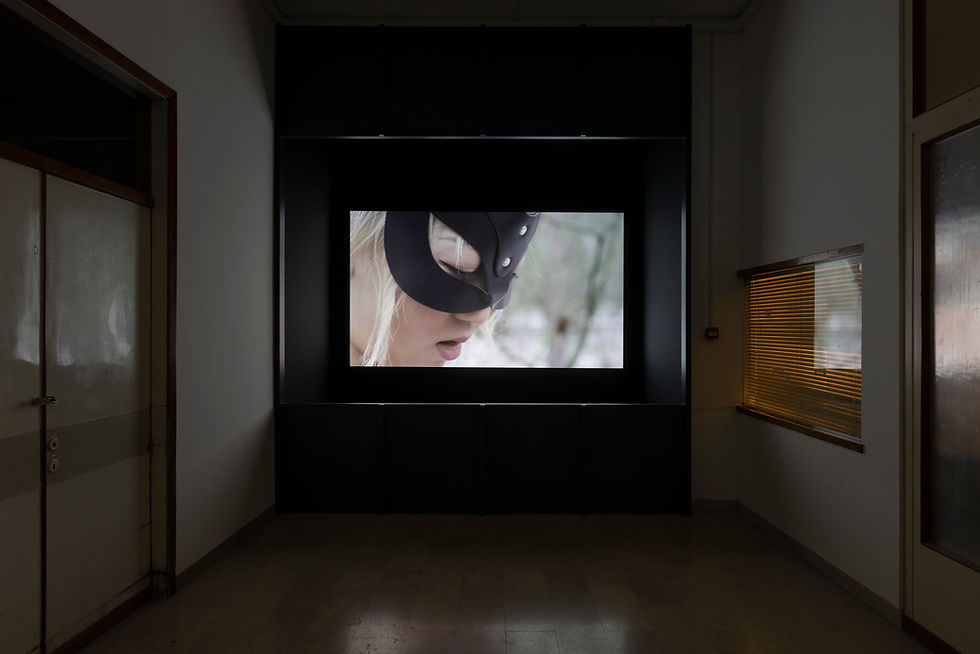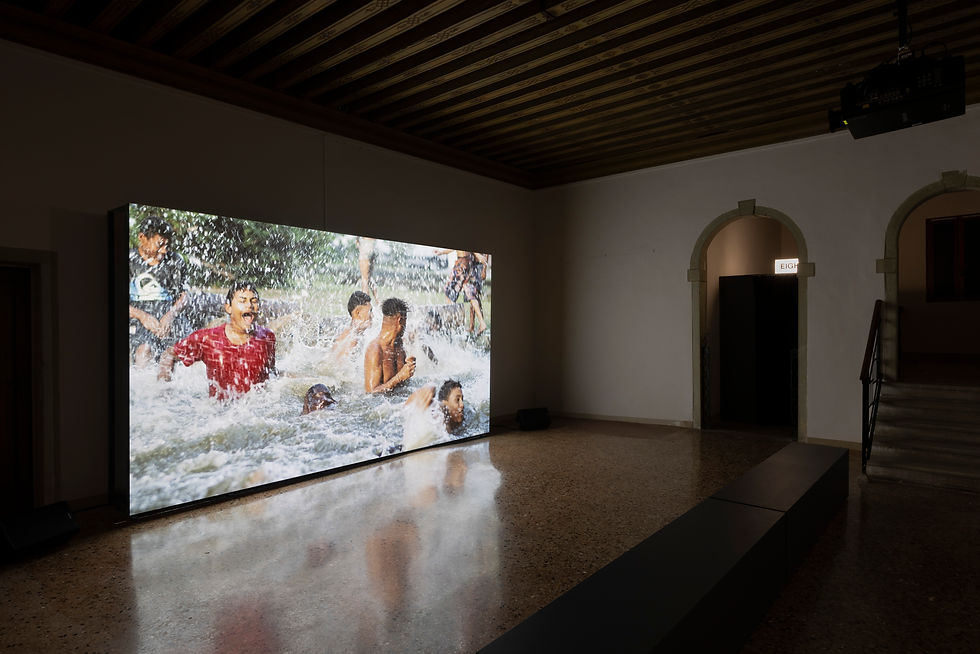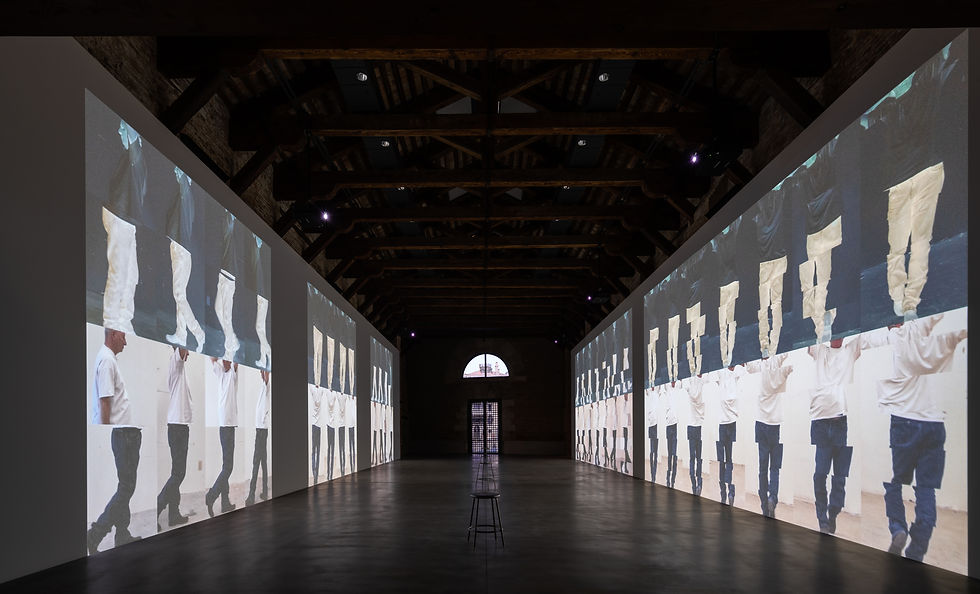(ESSAY) Posthuman, All Too Human, by William Kherbek
- William Kherbek
- Feb 24, 2023
- 9 min read

William Kherbek takes us on a theoretical and imaginative journey through the futurism of the artworks of the Venice Biennale in 2022, The Milk of Dreams, through which he interrogates the term ‘posthumanism’ and what it means for us, in our current post-internet age.
This year’s Venice Biennale, entitled The Milk of Dreams, was infused with the spirit of feminist futurism. Works that look both forward and backward and in entirely distinctive dimensions. The works of Lynn Hershman Leeson and Geumhyung Jeong offered examples of explicitly technologically realised futures, other artists, for example Jane Graverol’s version of Belgian surrealism considered less the future than pasts that never go away. Graverol’s ‘L’École de la Vanité’ is an image that stayed with me, a fragile half-robotic sphinx with something like a lion’s paw gently holding a cut rose, and a serene female face complete with neatly trimmed bangs. Oneiric indeed: technical and mammalian, the work is both pre-human and post-human, and seeing it set off a chain of associations that saw me through a half a week in Venice, moving between exhibitions and trying to settle on an understanding of the grand discourses evoked in them.
Feminism, though a vexed term with its different waves and distinct traditions felt very much like a graspable feature of the exhibition at the Arsenale and at the Central Pavilion in the Giardini; but at a talk with Rosie Braidotti and others from earlier in the Biennale, the dynamics of the post-human and the feminist are also core themes this edition of the Biennale sought to evoke. Posthumanism as a term troubles me. The quantifying of the boundaries of the human has historically led to unhappy ends. There’s a certain kind of essentialism at the core of the proposition: there is something that is human that we can identify, and something that is other-than-human which, even if one accepts we can’t understand it exactly, we can also identify. Many, including Francesca Ferrando (‘Humans Have Always Been Posthuman’), have suggested we’ve always been posthuman. Others have taken it a step further: ‘We Have Always Already Been Becoming Posthuman?’, or so queries Roman Bartosch in his (humanoid) tongue in (post-humanoid) cheek title of a study of the novel. To set the clock back to the beginning is one way of squaring a truly vicious circle, but there is a presentist question at the heart of such a presumption. Were we posthuman before we were human? Or immediately as we became human? What made us ‘human’ to begin with (the term derives, of course, for the Greek word ‘humando’, or ‘burying). Ferrando’s work suggests a kind of coeval process, that to be human is to be post-human, and the spiritual plain is where expressions of this phenomenon have been manifested historically. Venice, as will be discussed, is a good place to experience the contours of this.
Among the more unsatisfactory elements of discussing posthumanism is the question of whether posthumanism is just another face of humanism? Some theorists would have you believe it. Indeed, many sound like it when you read them no matter how totally they protest and say that NO! There is something distinctly, experientially different to a posthumanist cosmology than a humanist one. The Futurists writing in Milan at the beginning of the previous century might have agreed. Myself, I tend to think there is a tension in the discourse, something like a belief that once we can get over being human we can begin to treat each other more humanely. I wish I were that optimistic. We have already built many posthuman institutions: Self-targeting drones can make life and death decisions in the service of the ultimate post-human technology: the state. In Europe, governments seem to want their populations to hurry up and die before they can claim pensions. In America, the government seems to want people to hurry up and go to prison so their labour can be extracted for free. In Italy, anti-migrant discourse in the service of the Italian state is more counter-human than post-human. Economically, humans are superfluous to value creation. We have been for some time now. High frequency trading machines can generate (and destroy) value faster than the speed of human perception. Blockchain offers an ostensibly ‘trustless’ system of economic exchange and auditing. Neither of these frontiers of the posthuman are particularly encouraging, we are still more like the Graverol’s creature, unsettled, potentially dangerous, than we are machines of loving grace to use Robert Brautigan’s term.
The Biennale had many faces, all of them were human, but sometimes strangely so. On my way to the Arsenale, I dropped into the Mongolia Pavilion in Castello 2131. The exhibition A Journey Through Vulnerability was vastly stronger than its title. Munkhtsetseg Jalkhaajav is the artist. She brings together an eerie blend of the futuristic and the fundamental. The press text has its own opinion: ‘Mugi’s interdisciplinary works explore the notion of pain, fear, healing and rebirth. Many reflecting her personal experiences, she investigates complexities of female bodies, minds, and souls, and the connection with oneself and nature, while capturing tension between different realms’. The rooms of the exhibition are haunting, perhaps even haunted, especially a rough bed on which a kind of spiritual animal lies; cast in a kind of sleeve the being evokes both alien and oven mitt in equal measure. The works are equal parts alien and primeval, delving into the deepest recesses of the human imaginary but also looking into an unsettled future. When one learns that the story of a miscarriage is at the heart of the exhibition, posthuman enchantments start to seem protective, rooted in the ancient connection of humans to the forces of the earth, neither technological nor cultural, but animal. Among Mugi’s works, I was struck by the fact that in all the talk of the post-human, we’ve perhaps missed out the discussion of the ‘post-animal’. What would it mean to be ‘post-animal’. Is the post-animal imaginary itself a dangerous proposition? If we can experience the empress dolphin or the dodo entirely on our terms in a virtual realm, does their disappearance mean less? If Jurassic Park was meant to be a horror film, whose perspective would that interpretation be from? If we are posthuman where does that leave the rest of the animal kingdom, of which - last time I checked - humans were still a part? They have even less say in a future where organic beings and their needs are slowly encroached, or ostensibly backstopped, by virtuality. Extinction may be forever, but so is simulation.
Virtuality, of course, is at the heart of the posthuman discourse. N. Katherine Hayles, a pioneering figure in cybernetic theory posits we ‘became’ posthuman at the point of creation of virtual bodies, which became integrated into our sense of unitary identity. Lots of cyborg theory involves this relationship of virtuality and simulation, and as we enter the Web3 discourse, it is likely only to grow, but thinking back to Ferrando, in a city as drenched in religious iconography as Venice, the question of when ‘virtuality’ became part of a posthuman identity, and indeed what virtuality is, becomes impossible to ignore. Many would accept that saints having visions of Christ or other realms can only be analysed through the prism of abnormal psychology. Perhaps there is truth in this approach, but as soon as one attempts to distinguish between purely psychogenic experiences and technologically virtual ones, boundaries become unwelcomely blurry. The subjective and the objective would be a potential place to draw a firm line: I can’t experience the vision of St. Theresa in the same way I can experience Fortnite; thus, the capacity to access subjective experience becomes a mechanism of verification, but how then do we regard an intermediary act like reading a novel, or seeing an artwork? We can all agree on which book someone may be reading, but it’s not just adjunct professors who would be affected if there were only a single way to interpret the reading. Indeed, we could all agree upon looking at a brain scan of someone seeing a vision of what was happening, but its meaning would be different to different audiences. The posthuman imaginary is infinitely diverse, just like the human one…

The posthuman world will be one of infinite connections, but connectivity and connecting (pace E.M. Forster’s injunction to ‘only connect’) are concepts that are not always necessarily connected. I found myself thinking about this dynamic watching the film ‘House of Nations’ by He Xiangyu in an exhibition of films entitled Penumbra at Complesso Dell’Ospedaletto. He’s film follows a young Chinese protagonist through COVID-19 era Berlin. The world seen by He’s protagonist is not so much antagonistic as profoundly disconnected. Permanently tethered to screens and floods of information, essentially infinite connectedness to the world only makes the experience lonelier, and the subject more atomised. Characters in He’s film seem to be seeking a kind of immediacy of experience; drinking strong spirits on a rooftop, eating snow as it falls from a tree branch, there is a certain romanticism to He’s film that fits the Venetian context. Romanticism conjures a specific set of associations, perhaps, but He’s romanticism touches on the origins of the term: the intense experience of individualised perception and understanding. The world He depicts in ‘House of Nations’ is filled with longing and absence. What does posthuman longing look like?

Posthuman romanticism: is it an idea whose time has come? Romanticism has a way of morphing almost as easily as a digital image. In art it has often been a sine qua non for humanism. The individual experience and individual consciousness lies at the centre of various romantic artistic movements. One of the shows I saw made me wonder if one could experience a posthuman romanticism not defined by technology, but by absence. Most evenings during my trip to Venice, I’d make my way to an ongoing performance series by Claire Zakiewicz. Zakiewicz’ exhibition, Tintoretto’s Daughter which was taking place in a small gallery called ARTATELIER, became something of a nightly puzzle. For Tintoretto’s Daughter, the artist undertook two hours of performance drawing to a prerecorded soundtrack. I watched from the windowsill outside the gallery - COVID measures (remember those?) prevented anyone but Zakiewicz and her collaborator, Mark Smith, into the space. I’ve seen performances by Zakiewicz before in London. Often she works with improvisational musicians and/or dancers. In those shows, the dialogue between forms of improvisation felt more directly explicit, a kind of subspecies of call and response. To an extent it worked, but there could also be an excess of knowability in these type of events: you know the improvisers are improvising now. In the case of Zakiewicz and Smith, the dynamic was somewhat different, and I couldn’t help feeling more conceptually fruitful. Zakiewicz would draw as the soundtrack, an evolving mix of pieces that seemed to range from 90s guitar soundscapes to gossamer electronic skeins, played. Smith would photograph her over the course of the two hours. It was documentation, of a kind, certainly, but there was an additional layer for me in the dialogue of the fleeting act of drawing, and the capture of the camera. I confess to having begun to think that the emerging works on large paper surfaces hung along the gallery walls were somewhat beside the point. The artwork was somewhere else. But it wasn’t so much in the dialogue between Smith and Zakiewicz, and it wasn’t in the spectacle. For me, it was in the moments that the camera didn’t catch. The inherent loss that documentation implies. To see the moment captured is to see the disappearance of another moment. Loss, the enemy of digital culture, seemed as much where Zakiewicz’s art’s profundity emerged as with any of the residual images.

On my last day in Venice, I set out to see the Bruce Nauman retrospective at the Punta Della Dogana. The exhibition was a mix of classic works, ‘Violin Tuned D.E.A.D.’, ‘Beckett Walk’, and, of course variations on Nauman’s most widely acknowledged masterpiece, ‘Walking in an Exaggerated Manner Around the Perimeter of a Square’. Newer Nauman works used screens and edits to estrange the elements of the original work; this is how one becomes posthuman in the most literal way. Various Naumans now were layered over one another, absently meandering their own pathways. Nauman continues to take his famous lines for walks, but as his body ages. In the future, meta-Naumans would surely be walking around the corporate Web3 offices in his trademark jeans and T-shirt on casual Fridays into eternity. Perhaps the posthuman will only make us more ourselves. For me, this is the most terrifying thought of all.
I left on my train back to Berlin with no conclusions, only a sense that posthumanism would be of service to art for as long as the humans who make art need it. The question that continued to trouble me was this: does the posthuman need art? Ideas have needs of their own after all, what will happen when the posthuman is finished with us?
Posthuman post-scriptum
On the train home I wrote haikus about the exhibitions I saw in Venice. Here they are:
Marlene Dumas
Moving through rooms where
Bodies receive you. So many;
All of them hers.
Bruce Nauman
The old man walks the
Same line as the young man; the
Future grows longer.
He Xiangyu
Two are walking in
The snow, together with
Infinity, alone.
Mugi
Silver dreams of the
Phantom beasts inside us. An
empty bed, too full.
Claire Zakiewicz
It is in its own
making that the artwork
unmakes itself.
-
Text: William Kherbek
Images:
Images 1 & 2: He Xiangyu , House of Nations , 2021 in “ Penumbra ” , Fondazione In Between Art Film presso Complesso dell ’ Ospedaletto, Venezia, 2022. Courtesy dell ’ artista e Fondazione In Between Art Film. Photo: Andrea Rossetti
Image 3: Claire Zakiewicz, Tintoretto's Daughter, Photo: Mark Edward Smith, 2022
Image 4: Bruce Nauman, Contrapposto Studies, I through VII, 2015-2016, Jointly owned by Pinault Collection and the Philadelphia Museum of Art. Installation View, Bruce Nauman: Contrapposto Studies at Punta della Dogana, 2021. Ph. Marco Cappelletti © Palazzo Grassi © Bruce Nauman by SIAE 2021
Published 24/2/23
This is a deep and interesting thought. It made me think about art and the future in a simple way. I wonder if art will always need humans. Clear writing like this is helpful, just like good executive cv writing services help people share their story.
Examining the work of Kherbek, Posthuman, All Too Human helped expand my thinking into the topic. When I needed some extra assistance, I found an affordable thesis writer who guided my thoughts in arranging and analysing Kherbek's process of argumentation. It made tackling the ideas of alternative realities more manageable, and sticking to a well-organized and well-considered essay, even in spite of the difficult material. Affordable and skilled support ultimately led to improvements in my learning progress.